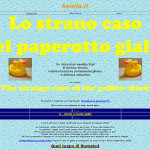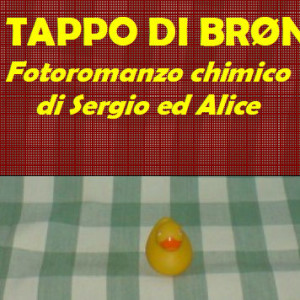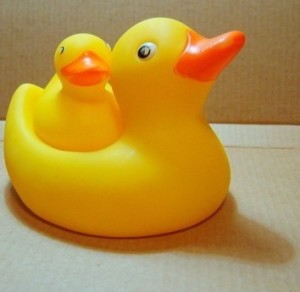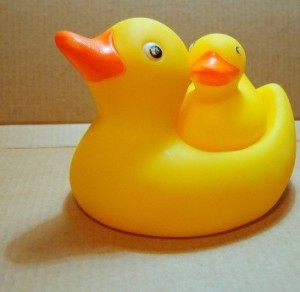Una delle prime cose ad apparire su kemia.it, nel 2006, era stata la chimica del paperotto giallo.

L’idea è quella di descrivere agli studenti più giovani come si arrivi alla comprensione della struttura atomica della materia, di quando esistano le molecole e così via, ribaltando una serie di luoghi comuni abbastanza assurdi che si sono via via trasformati in una didattica mainstream, basata acriticamente su quanto viene presentato dalle versioni correnti dei libri di testo scolastici.
Poi gli anni sono passati ed il progetto era rimasto fermo. Ora che sta ripartendo, pubblico qui i testi originali con il minimo indispensabile di correzioni. Quanto prima vorrei riuscire a sistemare anche i pdf, in formato agevole a chi guarda lo schermo di un cellulare.

Quel tappo di Brønsted, un breve fotoromanzo sulla reazione di trasferimento protonico, è uno spin-off di queste proposte didattiche, nato di getto da una chiacchierata con Alice che stava per iniziare la prima media, e realizzato un paio d’ore il primo settembre 2009.
Negli anni ho scoperto che il paperotto giallo è una presenza diffusa tra i chimici, molti dei quali lo usano come animale totemico un po’ come me. Evviva, anzi: quack!
Lo strano caso del paperotto giallo – De paperis et peperoncinis (it)
I capitoli (pdf, it)
The strange case of the yellow duck – De paperis et peperoncinis (en)
Lo strano caso del paperotto giallo
Un misterioso
cockducktail
di chimica teorica,
indeterminazione preheisenberghiana
e didattica ackuatica
De paperis et peperoncinis
Non ricordo quando e come sia nato il paperotto giallo.
La prima volta doveva essere uno degli esempi improvvisati che tiro fuori dal cappello durante le lezioni, soprattutto per non dire sempre le stesse cose con le stesse parole. Ricordo che, la volta successiva in cui ne ho parlato, mi ero presentato in classe con il papà papero e la paperina che si vedono nella fotografia, con i quali Alice già faceva il bagnetto, per cui immagino fosse circa il ’99 – 2000. Molti anni prima che avessi un sito personale.Poi, tutto sommato, la cosa è piaciuta, mi sono divertito a ritirarla fuori dopo parecchio tempo e c’è sempre qualche studente che rimane perplesso o scandalizzato a vedermi, serioso e incravattato, a fare il cabaret molecolare con la bestiola: quindi, probabilmente sono nel giusto.
Ripenso a un’ochetta giuliva, con starnazzanti genitori al seguito, che a quei tempi mi accusava di non capire un /bip/ di chimica perchè per spiegare i reticoli cristallini avevo fatto l’esempio di un vasetto di peperoncini farciti, e altri simili abominii, anziché farle studiare a memoria le litanie unoessedùe dueessedùe e le sette preparazioni dei sali, come fanno quelli che la chimica la sanno insegnare davvero…
Un paio d’anni dopo, l’amico Dario Bressanini era venuto all’istituto Monnet a presentare questa conferenza, dove a pag. 59 compare una rappresentazione di densità elettronica che, per qualche ragione, aveva evidenziato in color oro. Da una fila dietro ho sentito un studente che avevo avuto al biennio (la classe dell’ochetta, eh eh), mentre diceva ad un compagno: “hai visto, che è proprio giallo?!”. Risate e goduria.
Se un teorico rigoroso ed un ottimo divulgatore come Dario non ha problemi né con il diavoletto di Maxwell né con Paperino o Snoopy, penso che continuerò ad andare a spasso con il mio paperotto ed a ritenere che un atomo sia una cosa gialla, soffice e simpatica.
Comunque sono sicuro che la mia paperottologia a qualcuno non vada proprio giù.
La chimica è un’altra cosa, molto più seria, e se non è noiosa non può essere chimica!Come risposta, suggerisco questo collegamento alla Fondazione Nobel che usa proprio i paperotti gialli per introdurre alla chimica delle materie plastiche.
Se non ti va bene nemmeno questo, sei un noioso da premio Nobel!(rev. luglio 2010)
I capitoli
1 – Introduzione, rev. 0.4
2 –
3 –
4 –
5 – Atomi e piume gialle, rev. 0.4
6
7
The strange case of the yellow duck
A mysterious
cockducktail
of theoretical chemistry,
preheisenbergian indetermination
and aquacktic didactic.
If you really need a foreword, it’s here. English translations of the early drafts are still unavailable. First two pdf’s with the rearranged Italian texts were issued on August 2009. The beauty of the web is that you can rethink the text how many times you want, in printed books you find a lot of things to improve as soon as you get them bound.
The picture story about acids and bases, instead, was born suddenly on September 1, 2009, sitting at lunch with my daughter Alice (then 10), and in a couple of hours it was done.
Anyway, I’m sure that someone finds my duckology really unbearable. Chemistry is different, much more serious: if it’s not boring, it’s not chemistry!
In response, I suggest this link to the Nobel Foundation, where precisely the yellow duck is used to introduce the chemistry of plastics.
If you don’t like even that, you are nominated to the Nobel Prize in Dullness!* * * * * *
De paperis et peperoncinis (English)
I don’t remember how and when the yellow duck was born.
The first time, it could have been one of that examples that I’m used to pull out of the hat during my lessons, in order not to repeat all the same things with all the same words. I remember that the next time I spoke about it, I appeared in the classroom with daddy duck and his little yellow daughter, which you see in the picture, and with whom Alice was used to take her bath, so I guess it was about ’99 or 2000. Many years before my personal website.That time, after all, the thing was appreciated. So I enjoy to shoot it off the cap again, sometimes, and there are always some students who remain puzzled or shocked to see me, serious in my silk tie, doing molecular cabaret with the little beast: therefore, probably I am right.
I think of an young silly goose, with her cortege of squawking parents, who at that time accused me of not understanding a /***/ about chemistry, as I was explaining crystal lattices with the aid of a jar of stuffed round chillies, and other similar abominations. Instead, I should teach them the litany one-s-two, two-s-two, and the seven preparations of salts, the way those who know the Real Chemistry are used to teach…
A couple of years later, my friend Dario Bressanini was at the Monnet institute to give this lecture, where on page 59 he shows a representation of electron density that, who knows why, was highlighted in gold. Then I heard one of my former students who sat in the back row (a classmate of the silly goose), crying to a friend: “Look, it’s really yellow!” Lots of laugh!
If a rigorous theoretical and an excellent communicator as Dario has no problems with the Maxwell’s demon or with Donald Duck or Snoopy, I believe that I will continue to go around with my ducks, thinking that an atom is something yellow, pleasant and soft.
(ed. July 2010)
p.s. (2006-2016): nell’augurio di non avere leso alcun copyright altrui, ed essendo disponibile ad ogni confronto del caso, segnalo che queste pagine e in particolare la metafora del paperotto giallo (ed ogni esempio derivato da essa) sono mie proprietà intellettuali per le quali gradisco sia citato l’autore e il sito www.kemia.it, secondo lo schema Creative Commons citato alla fine della pagina. Trattandosi di un lavoro ancora ampiamente nella fase di sviluppo, queste pagine verranno progressivamente aggiornate ed integrate; al momento le ritengo ancora bozze preliminari.


